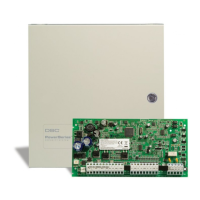2
Memory
• CMOS EEPROM memory
• Retains programming and system status on AC and battery
failure
• Data Retention: 200 years min.
Programmable Outputs (PGMs)
• Up to 14 programmable outputs (PGM) with 21 options
• PGM outputs are open collector type and switched to
ground
• Three low current (50mA) PGM outputs on main panel
(PGM1, PGM3, PGM4)
NOTE:
PGM3 and PGM4 available on PC1864 only.
• One high current (300mA) output with 2-wire smoke detec-
tor capability on the main control board (PGM2)
• Eight additional low current outputs (50mA) available using
the Model PC5208
• Four high current outputs (1A) available using the Model
PC5204 (one configurable as a supervised bell output)
Power Supply
• 1.5A regulated (1.7A for UL/ULC), supervised and integral
to the control unit
• Type A as per EN50131-6 Standard
• Input ratings: 120V, 60Hz Class II (220V-240Vac, 50/60Hz,
200mA for European installations)
• Transformer required, mounted in the same enclosure,
permanently connected for European installations
• Transformer secondary ratings: 16.5Vac, 40VA min
• AUX Output Voltage: 12V
DC, -15%/+10% when AC Input
Voltage is 85% to +110% of rated value and output current
is 500mA (700mA for UL/ULC) (550mA for IMQ)
• Output ripple voltage: 270mVp-p max.
• Storage device: Rechargeable battery, rated 12V
DC
• Battery capacity: 4Ah, 7Ah, 14Ah (2 x 7Ah) or 24 Ah (2 x
12Ah)
• Battery = One 12V 4Ah battery (For burglary applications)
• Battery = Two 12V 7Ah (min.) rechargeable sealed lead
acid for 24-hr backup (For fire monitoring applications)
• Maximum standby time 24h (when using 14Ah battery
capacity and AUX current limited to 480mA max.).
• Recharging time 48h
• Programmable recharging current: Low 400mA, High
700mA
• Low battery trouble indication threshold 11.5V
DC
• Battery deep discharge protection (cut-off at 9.5VDC)
• Main board current draw: 85mA (set and unset state)
• Resettable fuses (PTC) used on circuit board instead of
replaceable fuses
• Supervision for loss of primary power source (AC Fail), bat-
tery fail or battery low voltage (Battery Trouble) with indica-
tion provided on the keypad
• Internal clock locked to AC power frequency
Operating Environmental Conditions
• Temperature range: -10°C to +55°C (14°F to 131°F)
• Relative humidity: 93% non condensing
Keypad Specifications
• Each keypad has 5 fully programmable function keys (see
Section [000] in the programming section.
• “T” version keypads have tamper protection
• Connect up to 8 keypads
• Four wire (Quad) connection to Keybus
• Built in piezoelectric buzzer
Alarm Transmitter Equipment (ATE) Specification
• Digital dialer integral to the main control board
• Complies with TS103 021-1, -2, -3 Telecom equipment
requirements
• Supports the following communications formats:
• 10 BPS/20 BPS
• DTMF Contact ID
• SIA FSK
• Pager
• Residential Dial
• Private Line
• Scantronics 4-8-1
• Robofon
• CESA 200
• Split reporting of selected transmissions to each telephone
number
• 3 programmable telephone numbers
• 1 system account number
• Upto 8 partition account numbers
• Supports Skyroute™ Cellemetry Communication Trans-
ceiver
• GS3050 GSM Universal Wireless Alarm Communicator
• DTMF and pulse dialing
• DPDT line seizure
• Anti-jam detection
• Event-initiated personal paging
• T-Link/T-Link TL250/T-Link TL300 Ethernet Communica-
tions (using PC-Link) for Intranet/Internet connectivity.
System Supervision Features
The PC1616/PC1832/PC1864 continuously monitors a number of
possible trouble conditions and provides audible and visual indi-
cation at the keypad. Multiple signals are indicated using scroll
buttons on the LCD keypads (no priority assigned) or by different
lights on the LED’s keypads. Trouble Conditions include:
• AC Power Failure
• Low Battery Condition
• AUX Power Supply Fault
• Bell Output Trouble
• Telephone Line Trouble
• Failure to Communicate
• Loss of Internal Clock
• Module Fault (Supervisory or Tamper)
• Trouble by Zone
• Fire Trouble
• Tamper by Zone
False Alarm Prevention Features
• Audible Exit Delay
• Audible Exit Fault
• Urgency on Entry Delay
• Quick Exit
• Swinger Shutdown
• Recent Closing Reporting Code
• Cross Zone/Police Code Alarm
• Burglary-Verified Timer
• Communication Delay
• Rotating Keypress Buffer
Additional Features
• Automatic inhibit (swinger shutdown) for Alarm, Tamper,
Trouble signals after 3 occurrences in a given set period
(see section [377]), Opt [1] alarms, [2] tampers, [3] trou-
bles.
• Programmable keypad lockout option (see section [012])
• Automatic arming by partition at a specified time, each day
of the week
• No activity arming
• Keypad activated alarm output and communicator test

